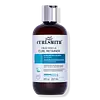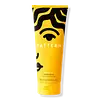What's inside
What's inside
 Key Ingredients
Key Ingredients

 Benefits
Benefits

 Concerns
Concerns

 Ingredients Side-by-side
Ingredients Side-by-side

Water
Skin ConditioningPropanediol
SolventHelianthus Annuus Seed Extract
Skin ConditioningHydrolyzed Corn Starch
HumectantCorn Starch Modified
AbsorbentArgania Spinosa Kernel Oil
EmollientCitrullus Lanatus Seed Oil
EmollientRibes Nigrum Seed Oil
EmollientPanthenol
Skin ConditioningHelianthus Annuus Seed Oil
EmollientPvp
Emulsion StabilisingCocos Nucifera Seed Butter
Skin ConditioningNiacinamide
SmoothingSqualane
EmollientGlycerin
HumectantC9-12 Alkane
SolventCoco-Caprylate/Caprate
EmollientBehentrimonium Chloride
PreservativeCaesalpinia Spinosa Gum
Skin ConditioningPolyacrylate Crosspolymer-6
Emulsion StabilisingTocopherol
AntioxidantLaureth-2
CleansingPentylene Glycol
Skin ConditioningSodium Gluconate
Skin ConditioningSodium Hydroxide
BufferingCitric Acid
BufferingEthylhexylglycerin
Skin ConditioningPhenoxyethanol
PreservativeSodium Benzoate
MaskingPotassium Sorbate
PreservativeParfum
MaskingLimonene
PerfumingLinalool
PerfumingCitronellol
PerfumingAlpha-Terpinene
PerfumingDimethyl Phenylethyl Carbinyl Acetate
PerfumingTetramethyl Acetyloctahydronaphthalenes
MaskingCitrus Limon Peel Oil
MaskingCitrus Aurantium Peel Oil
Pinene
MaskingRose Ketone-4
PerfumingVanillin
MaskingWater, Propanediol, Helianthus Annuus Seed Extract, Hydrolyzed Corn Starch, Corn Starch Modified, Argania Spinosa Kernel Oil, Citrullus Lanatus Seed Oil, Ribes Nigrum Seed Oil, Panthenol, Helianthus Annuus Seed Oil, Pvp, Cocos Nucifera Seed Butter, Niacinamide, Squalane, Glycerin, C9-12 Alkane, Coco-Caprylate/Caprate, Behentrimonium Chloride, Caesalpinia Spinosa Gum, Polyacrylate Crosspolymer-6, Tocopherol, Laureth-2, Pentylene Glycol, Sodium Gluconate, Sodium Hydroxide, Citric Acid, Ethylhexylglycerin, Phenoxyethanol, Sodium Benzoate, Potassium Sorbate, Parfum, Limonene, Linalool, Citronellol, Alpha-Terpinene, Dimethyl Phenylethyl Carbinyl Acetate, Tetramethyl Acetyloctahydronaphthalenes, Citrus Limon Peel Oil, Citrus Aurantium Peel Oil, Pinene, Rose Ketone-4, Vanillin
Water
Skin ConditioningCetearyl Alcohol
EmollientBehentrimonium Methosulfate
Caprylic/Capric Triglyceride
MaskingButylene Glycol
HumectantBiotin
AntiseborrhoeicPanthenol
Skin ConditioningSimmondsia Chinensis Seed Oil
EmollientRicinus Communis Seed Oil
MaskingPersea Gratissima Oil
Skin ConditioningOlea Europaea Fruit Oil
MaskingMelaleuca Alternifolia Leaf Oil
AntioxidantMel
EmollientCocos Nucifera Oil
MaskingArgania Spinosa Kernel Oil
EmollientPrunus Amygdalus Dulcis Oil
Skin ConditioningButyrospermum Parkii Oil
EmollientHydrolyzed Vegetable Protein Pg-Propyl Silanetriol
Skin ConditioningAloe Barbadensis Leaf Extract
EmollientTocopherol
AntioxidantPolyquaternium-37
Propylene Glycol Dicaprylate/Dicaprate
EmollientEthylhexylglycerin
Skin ConditioningTrideceth-3
EmulsifyingTrideceth-15
EmulsifyingCetrimonium Chloride
AntimicrobialAmodimethicone
Parfum
MaskingPPG-1 Trideceth-6
Skin ConditioningGlycerin
HumectantAminomethyl Propanol
BufferingPhenoxyethanol
PreservativeCitric Acid
BufferingAlcohol
AntimicrobialAcetic Acid
BufferingPotassium Sorbate
PreservativeDisodium EDTA
Linalool
PerfumingAmyl Cinnamal
PerfumingButylphenyl Methylpropional
PerfumingBenzyl Benzoate
AntimicrobialHydroxycitronellal
PerfumingCitronellol
PerfumingCoumarin
PerfumingLimonene
PerfumingHexyl Cinnamal
PerfumingWater, Cetearyl Alcohol, Behentrimonium Methosulfate, Caprylic/Capric Triglyceride, Butylene Glycol, Biotin, Panthenol, Simmondsia Chinensis Seed Oil, Ricinus Communis Seed Oil, Persea Gratissima Oil, Olea Europaea Fruit Oil, Melaleuca Alternifolia Leaf Oil, Mel, Cocos Nucifera Oil, Argania Spinosa Kernel Oil, Prunus Amygdalus Dulcis Oil, Butyrospermum Parkii Oil, Hydrolyzed Vegetable Protein Pg-Propyl Silanetriol, Aloe Barbadensis Leaf Extract, Tocopherol, Polyquaternium-37, Propylene Glycol Dicaprylate/Dicaprate, Ethylhexylglycerin, Trideceth-3, Trideceth-15, Cetrimonium Chloride, Amodimethicone, Parfum, PPG-1 Trideceth-6, Glycerin, Aminomethyl Propanol, Phenoxyethanol, Citric Acid, Alcohol, Acetic Acid, Potassium Sorbate, Disodium EDTA, Linalool, Amyl Cinnamal, Butylphenyl Methylpropional, Benzyl Benzoate, Hydroxycitronellal, Citronellol, Coumarin, Limonene, Hexyl Cinnamal
Ingredients Explained
These ingredients are found in both products.
Ingredients higher up in an ingredient list are typically present in a larger amount.
You may know this ingredient as argan oil. Argan Oil has antioxidant, hydrating, and soothing properties.
Studies have shown argan oil can help fight again radical damage from the sun. This makes it effective at preventing hyperpigmentation.
Large amounts of vitamin E found in argan oil helps the skin retain water. Argan oil also contains fatty acids such as linoleic acid, oleic acid, and palmitic acid. It is also a good source of lipids.
Another benefit of argan oil is skin-soothing. It can help reduce inflammation-related skin symptoms.
Argan Oil is effective at regulating sebum production in pores. This can make it effective at treating hormonal acne.
Traditionally, argan oil was used for its antibacterial and antifungal properties. However, argan oil contains fatty acids that may make it not fungal-acne safe.
Argan Trees are native to Morocco.
Learn more about Argania Spinosa Kernel OilCitric Acid is an alpha hydroxy acid (AHA) naturally found in citrus fruits like oranges, lemons, and limes.
Like other AHAs, citric acid can exfoliate skin by breaking down the bonds that hold dead skin cells together. This helps reveal smoother and brighter skin underneath.
However, this exfoliating effect only happens at high concentrations (20%) which can be hard to find in cosmetic products.
Due to this, citric acid is usually included in small amounts as a pH adjuster. This helps keep products slightly more acidic and compatible with skin's natural pH.
In skincare formulas, citric acid can:
While it can provide some skin benefits, research shows lactic acid and glycolic acid are generally more effective and less irritating exfoliants.
Most citric acid used in skincare today is made by fermenting sugars (usually from molasses). This synthetic version is identical to the natural citrus form but easier to stabilize and use in formulations.
Read more about some other popular AHA's here:
Learn more about Citric AcidCitronellol is used to add fragrance/parfum to a product. It is often derived from plants such as roses. In fact, it can be found in many essential oils including geranium, lavender, neroli, and more. The scent of Citronellol is often described as "fresh, grassy, and citrus-like".
Since the Citronellol molecule is already unstable, Citronellol becomes irritating on the skin when exposed to air.
Citronellol is a modified terpene. Terpenes are unsaturated hydrocarbons found in plants. They make up the primary part of essential oils.
Citronellol is not able to be absorbed into deeper layers of the skin. It has low permeability,
Citronellol is also a natural insect repellent.
Learn more about CitronellolEthylhexylglycerin (we can't pronounce this either) is commonly used as a preservative and skin softener. It is derived from glyceryl.
You might see Ethylhexylglycerin often paired with other preservatives such as phenoxyethanol. Ethylhexylglycerin has been found to increase the effectiveness of these other preservatives.
Glycerin is already naturally found in your skin. It helps moisturize and protect your skin.
A study from 2016 found glycerin to be more effective as a humectant than AHAs and hyaluronic acid.
As a humectant, it helps the skin stay hydrated by pulling moisture to your skin. The low molecular weight of glycerin allows it to pull moisture into the deeper layers of your skin.
Hydrated skin improves your skin barrier; Your skin barrier helps protect against irritants and bacteria.
Glycerin has also been found to have antimicrobial and antiviral properties. Due to these properties, glycerin is often used in wound and burn treatments.
In cosmetics, glycerin is usually derived from plants such as soybean or palm. However, it can also be sourced from animals, such as tallow or animal fat.
This ingredient is organic, colorless, odorless, and non-toxic.
Glycerin is the name for this ingredient in American English. British English uses Glycerol/Glycerine.
Learn more about GlycerinLimonene is a fragrance that adds scent and taste to a formulation.
It's found in the peel oil of citrus fruits and other plants such as lavender and eucalyptus. The scent of limonene is generally described as "sweet citrus".
Limonene acts as an antioxidant, meaning it helps neutralize free radicals.
When exposed to air, oxidized limonene may sensitize the skin. Because of this, limonene is often avoided by people with sensitive skin.
The term 'fragrance' is not regulated in many countries. In many cases, it is up to the brand to define this term. For instance, many brands choose to label themselves as "fragrance-free" because they are not using synthetic fragrances. However, their products may still contain ingredients such as essential oils that are considered a fragrance.
Learn more about LimoneneLinalool is a fragrance and helps add scent to products. It's derived from common plants such as cinnamon, mint, citrus, and lavender.
Like Limonene, this ingredient oxidizes when exposed to air. Oxidized linalool can cause allergies and skin sensitivity.
This ingredient has a scent that is floral, spicy tropical, and citrus-like.
Learn more about LinaloolPanthenol is a common ingredient that helps hydrate and soothe the skin. It is found naturally in our skin and hair.
There are two forms of panthenol: D and L.
D-panthenol is also known as dexpanthenol. Most cosmetics use dexpanthenol or a mixture of D and L-panthenol.
Panthenol is famous due to its ability to go deeper into the skin's layers. Using this ingredient has numerous pros (and no cons):
Like hyaluronic acid, panthenol is a humectant. Humectants are able to bind and hold large amounts of water to keep skin hydrated.
This ingredient works well for wound healing. It works by increasing tissue in the wound and helps close open wounds.
Once oxidized, panthenol converts to pantothenic acid. Panthothenic acid is found in all living cells.
This ingredient is also referred to as pro-vitamin B5.
Learn more about PanthenolParfum is a catch-all term for an ingredient or more that is used to give a scent to products.
Also called "fragrance", this ingredient can be a blend of hundreds of chemicals or plant oils. This means every product with "fragrance" or "parfum" in the ingredients list is a different mixture.
For instance, Habanolide is a proprietary trade name for a specific aroma chemical. When used as a fragrance ingredient in cosmetics, most aroma chemicals fall under the broad labeling category of “FRAGRANCE” or “PARFUM” according to EU and US regulations.
The term 'parfum' or 'fragrance' is not regulated in many countries. In many cases, it is up to the brand to define this term.
For instance, many brands choose to label themselves as "fragrance-free" because they are not using synthetic fragrances. However, their products may still contain ingredients such as essential oils that are considered a fragrance by INCI standards.
One example is Calendula flower extract. Calendula is an essential oil that still imparts a scent or 'fragrance'.
Depending on the blend, the ingredients in the mixture can cause allergies and sensitivities on the skin. Some ingredients that are known EU allergens include linalool and citronellol.
Parfum can also be used to mask or cover an unpleasant scent.
The bottom line is: not all fragrances/parfum/ingredients are created equally. If you are worried about fragrances, we recommend taking a closer look at an ingredient. And of course, we always recommend speaking with a professional.
Learn more about ParfumPhenoxyethanol is a preservative that has germicide, antimicrobial, and aromatic properties. Studies show that phenoxyethanol can prevent microbial growth. By itself, it has a scent that is similar to that of a rose.
It's often used in formulations along with Caprylyl Glycol to preserve the shelf life of products.
Potassium Sorbate is a preservative used to prevent yeast and mold in products. It is commonly found in both cosmetic and food products.
This ingredient comes from potassium salt derived from sorbic acid. Sorbic acid is a natural antibiotic and effective against fungus.
Both potassium sorbate and sorbic acid can be found in baked goods, cheeses, dried meats, dried fruit, ice cream, pickles, wine, yogurt, and more.
You'll often find this ingredient used with other preservatives.
Learn more about Potassium SorbateTocopherol (also known as Vitamin E) is a common antioxidant used to help protect the skin from free-radicals and strengthen the skin barrier. It's also fat soluble - this means our skin is great at absorbing it.
Vitamin E also helps keep your natural skin lipids healthy. Your lipid skin barrier naturally consists of lipids, ceramides, and fatty acids. Vitamin E offers extra protection for your skin’s lipid barrier, keeping your skin healthy and nourished.
Another benefit is a bit of UV protection. Vitamin E helps reduce the damage caused by UVB rays. (It should not replace your sunscreen). Combining it with Vitamin C can decrease sunburned cells and hyperpigmentation after UV exposure.
You might have noticed Vitamin E + C often paired together. This is because it is great at stabilizing Vitamin C. Using the two together helps increase the effectiveness of both ingredients.
There are often claims that Vitamin E can reduce/prevent scarring, but these claims haven't been confirmed by scientific research.
Learn more about TocopherolWater. It's the most common cosmetic ingredient of all. You'll usually see it at the top of ingredient lists, meaning that it makes up the largest part of the product.
So why is it so popular? Water most often acts as a solvent - this means that it helps dissolve other ingredients into the formulation.
You'll also recognize water as that liquid we all need to stay alive. If you see this, drink a glass of water. Stay hydrated!
Learn more about Water